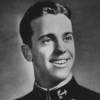Alan Shepard

Alan Shepard
Rear Admiral Alan Bartlett "Al" Shepard Jr.was an American naval officer and aviator, test pilot, one of the original NASA Mercury Seven astronauts, and businessman, who in May 1961 made the first manned Mercury flight. Shepard's craft entered space, but did not achieve orbit. He became the second person, and the first American, to travel into space, and the first person to manually control the orientation of his spacecraft...
NationalityAmerican
ProfessionAstronaut
Date of Birth18 November 1923
CityDerry, NH
CountryUnited States of America
The same way people are now paying a couple thousand dollars to fly to other parts of the world, people will be paying $50,000 to spend a weekend on a space station.
We need a continuing presence in space.
I didn't mind studying. Obviously math and the physical science subjects interested me more than some of the more artistic subjects, but I think I was a pretty good student.
We also knew it would be difficult, because of the financial condition of the family, for me to go to college.
Because of the suit I was wearing, I couldn't make a good pivot on the swing. And I had to hit the ball with one hand.
I think all of us certainly believed the statistics which said that probably 88% chance of mission success and maybe 96% chance of survival. And we were willing to take those odds.
Of course I was delighted the flight was over, but I still had to worry about cleaning up inside the cabin, I had to worry about the hatch, how to get in the sling, and so on.
So everything turned out fine, and we were given the opportunity to go to Washington and be briefed on the project of man in space, and given the opportunity to choose whether we wanted to get involved or not.
I woke up an hour before I was supposed to, and started going over the mental checklist: where do I go from here, what do I do? I don't remember eating anything at all, just going through the physical, getting into the suit. We practiced that so much, it was all rote.
We wanted to be in great shape, we wanted to be able to cope with zero gravity, we wanted to be able to cope with accelerations and decelerations and so on. So all of us trained so that we were probably in the best physical condition we had ever been in up until that point.
Unfortunately, the suit is so stiff, I can't do this with two hands, but I'm going to try a little sand-trap shot here.
The pilot looked at his cues of attitude and speed and orientation and so on and responded as he would from the same cues in an airplane, but there was no way it flew the same. The simulators had showed us that.
We had some adverse conditions in the '60s, in the '70s and the '80s. The agency has risen above that in the past and will rise above that again.
I just wanted to be the first one to fly for America, not because I'd end up in the pages of history books.